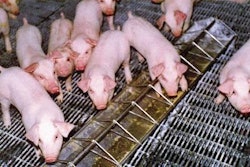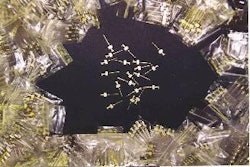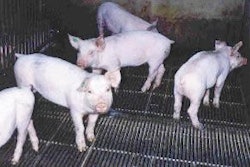.jpg?auto=format%2Ccompress&q=70&w=400)
For a country where most piglets are grown and finished away from their farm of origin, the arrival in Germany within the past year of an oral vaccine against the disease ileitis has raised an issue for marketing groups to resolve. They have needed to find a way of compensating the piglet producer for paying the cost of vaccinations that will benefit the grower-finisher.
Their answer has been to add the administration of the ileitis vaccine to the factors on which the piglet-producing members of the group are routinely audited. The customer now pays extra to buy pigs from the nursery with the equivalent of a label on each animal, guaranteeing that it has been vaccinated as desired.
As elsewhere, members have a choice on how they administer the vaccine. The options are individual dosing directly into the mouth, pen vaccination using a trough or batch administration through a proportioner pumping into the room's water line. American producers offered the same choices overwhelmingly have favoured proportioning, according to Enterisol Ileitis vaccine supplier Boehringer Ingelheim. About 95% of the oral vaccination with the product in the USA is done in this way. But the response in Germany, indeed throughout Europe, has been rather different.
An all-Europe estimate offered by the company to a recent Press meeting in Germany was that 60% of current administrations are by drenching. A further 35% are by the in-trough method for a single pen, but only 5% use a proportioner or medicator device.
The need in the USA to vaccinate bigger batches per unit probably provides part of the explanation for the difference, company veterinarians commented. No less influential, however, is the observation that ileitis has been occurring about 2 weeks earlier in Europe than in US herds. It means the Americans are vaccinating older pigs in order to have protection in place at the right moment against the causal organism Lawsonia intracellularis. In the past 2 years the European picture has shifted strongly towards an earlier onset of infection. This shift in age is suspected to be due to Europe's removal of its last in-feed antibiotic growth promoters, the suspicion being that the antibiotics had suppressed ileitis on infected units.
An information gap concerning the prevalence of the Lawsonia microbe on the European market has been plugged by a Europe-wide diagnostic survey started 2 years ago by Boehringer Ingelheimand its evidence warns that the infection is everywhere. Results presented to the meeting were from monitoring serological profiles by Elisa assay of pigs from 342 farms. This found only 6 farms (so, less than 2% of the total) which were apparently Lawsonia-freeand 2 of those were nursery-only sites while another 3 were the finishing units for multi-site enterprises. That left just one farrow-to-finish herd, which is being followed up to verify its status.

















